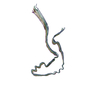+Search query
-Structure paper
| Title | Fully co-factor-free ClearTau platform produces seeding-competent Tau fibrils for reconstructing pathological Tau aggregates. |
|---|---|
| Journal, issue, pages | Nat Commun, Vol. 14, Issue 1, Page 3939, Year 2023 |
| Publish date | Jul 4, 2023 |
 Authors Authors | Galina Limorenko / Meltem Tatli / Rajasekhar Kolla / Sergey Nazarov / Marie-Theres Weil / David C Schöndorf / Daniela Geist / Peter Reinhardt / Dagmar E Ehrnhoefer / Henning Stahlberg / Laura Gasparini / Hilal A Lashuel /   |
| PubMed Abstract | Tau protein fibrillization is implicated in the pathogenesis of several neurodegenerative diseases collectively known as Tauopathies. For decades, investigating Tau fibrillization in vitro has ...Tau protein fibrillization is implicated in the pathogenesis of several neurodegenerative diseases collectively known as Tauopathies. For decades, investigating Tau fibrillization in vitro has required the addition of polyanions or other co-factors to induce its misfolding and aggregation, with heparin being the most commonly used. However, heparin-induced Tau fibrils exhibit high morphological heterogeneity and a striking structural divergence from Tau fibrils isolated from Tauopathies patients' brains at ultra- and macro-structural levels. To address these limitations, we developed a quick, cheap, and effective method for producing completely co-factor-free fibrils from all full-length Tau isoforms and mixtures thereof. We show that Tau fibrils generated using this ClearTau method - ClearTau fibrils - exhibit amyloid-like features, possess seeding activity in biosensor cells and hiPSC-derived neurons, retain RNA-binding capacity, and have morphological properties and structures more reminiscent of the properties of the brain-derived Tau fibrils. We present the proof-of-concept implementation of the ClearTau platform for screening Tau aggregation-modifying compounds. We demonstrate that these advances open opportunities to investigate the pathophysiology of disease-relevant Tau aggregates and will facilitate the development of Tau pathology-targeting and modifying therapies and PET tracers that can distinguish between different Tauopathies. |
 External links External links |  Nat Commun / Nat Commun /  PubMed:37402718 / PubMed:37402718 /  PubMed Central PubMed Central |
| Methods | EM (helical sym.) |
| Resolution | 3.1 Å |
| Structure data | EMDB-18874, PDB-8r3t: |
| Source |
|
 Keywords Keywords | PROTEIN FIBRIL / Tau / ClearTau / fibrils / aggregation / co-factor-free / heparin-free |
 Movie
Movie Controller
Controller Structure viewers
Structure viewers About Yorodumi Papers
About Yorodumi Papers






 homo sapiens (human)
homo sapiens (human)